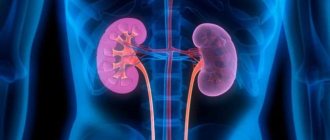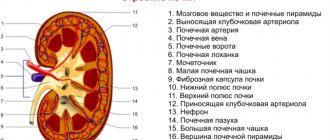Kidney hemodialysis
Hemodialysis is the process of purifying the blood using a special device, the so-called “artificial kidney”. In general, it is a selective semi-permeable membrane. The design of the device may be different, but the principle of operation remains the same: removal of substances from the blood by diffusion and convection methods.
- Diffusion is carried out in this way: on one side of the semi-permeable membrane there is the patient’s blood, on the other - the dialysate solution. Depending on the characteristics of the membrane, substances with a certain molecular weight can diffuse from the blood into the solution - from metal ions to large protein molecules.
Electrolytes or organic substances can also enter the blood from the dialysate solution, so the dialysate solution has the necessary concentration of electrolytes to restore their balance in the patient’s blood. The solution is thoroughly cleaned before use to prevent the introduction of toxins or bacteria.
- However, the diffusion method cannot remove hydrophobic hazardous substances from the blood. Convection is used for this. It is carried out through the same membrane due to the difference in pressure between the patient’s blood and the dialysate.
- Ultrafiltration is carried out due to blood pressure on the membrane created using a roller pump. In modern devices this process is controlled by a computer. This procedure removes excess fluid.
Hemodialysis allows you to cleanse the blood of the following substances:
- urea – a product of protein breakdown;
- creatinine – a product of energy metabolism;
- toxic substances such as strontium, arsenic, mushroom poison;
- various medications: barbiturates, tranquilizers, iodine and bromine compounds, salicylates, and so on;
- methyl and ethyl alcohol - therefore hemodialysis is also prescribed for acute poisoning;
- excess electrolytes - sodium, potassium, calcium;
- excess water.
The video shows the essence of the hemodialysis procedure:
Negative consequences
Hemodialysis is the only method, other than organ transplantation, that allows a patient with renal failure to live. However, the method has a number of negative consequences; complications of hemodialysis affect the patient’s quality of life. Such negative consequences include the conditions discussed below.
Arterial hypotension
It occurs as a result of a decrease in blood volume due to the rapid removal of fluid from the blood, which leads to a decrease in blood pressure.
If blood pressure drops, ultrafiltration is reduced or carried out within small limits
Arterial hypertension
In the presence of hypertension, hemodialysis patients experience complications:
- Vessels are damaged, which leads to the development of a stroke.
- Heart failure.
- Deterioration of vision.
- Decreased kidney function.
Nausea and vomiting
10% of patients experience these symptoms, for most of which the blood flow rate should be reduced by 1/3 at the beginning of hemodialysis.
Pain in the head area
Pain is associated with sharp fluctuations in blood pressure. More often this is a sign of impaired osmotic balance syndrome.
Pain in the head area is associated with sharp fluctuations in blood pressure, most often this is a sign of disturbed osmotic balance syndrome
Heart rhythm disturbance
An abnormal heart rhythm is accompanied by severe pain in the chest. After normalizing blood pressure and reducing the speed of blood flow, painful symptoms are eliminated.
Itchy skin
The symptom is caused by a failure of phosphorus-calcium metabolism; in the interval between hemodialysis, drug therapy and vitamin D are prescribed.
Anemia
Indicates a decrease in the required number of red blood cells in the blood that transport oxygen to the tissues. During hemodialysis, anemia develops for the following reasons:
- Deficiency of a hormone produced by the kidneys to stimulate the production of red blood cells.
- As a result of bleeding, blood loss during dialysis.
- Reduced iron intake due to dietary requirements.
Diseases of the bone skeleton
In patients with chronic renal failure, the absorption of calcium and phosphorus is impaired, and the body also does not receive enough vitamin D, which causes severe bone fragility.
Pericarditis
Occurs due to the lack of hemodialysis, when fluid accumulates in the heart area, which interferes with heart contractions and leads to a decrease in blood output.
Hyperkalemia
If the patient's diet contains high levels of potassium, this can cause cardiac arrest.
Peripheral neuropathy
The sensitivity of the limbs is impaired due to the development of diabetes mellitus and vitamin B12 deficiency.
Exhaustion
One of the severe manifestations is exhaustion. Although some doctors consider it a complication of chronic renal failure, and chronic hemodialysis acts as a provoking manipulation to increase catabolism and loss of amino acids. To replenish the body with proteins and calories, patients receive enhanced nutrition.
Indications for use
Hemodialysis is prescribed for pathological conditions when there is no other way to cleanse the blood of poisons.
These include:
- acute renal failure - with successful conservative treatment, a single procedure may be necessary to remove accumulated toxins. If the patient's situation does not improve, hemodialysis is carried out daily until the patient gets better;
- chronic failure - if functionality is maintained at 10-15%, hemodialysis is carried out 3 times a week. At 25% - 2 per week. The regimen is adjusted depending on the patient’s condition;
- pyelonephritis, acute glomerulonephritis;
- overhydration, which is life-threatening - pulmonary edema, cerebral edema. Here hemodialysis is combined with conservative therapy. If there is a threat to life, the first 3 sessions are carried out every day for 2 hours. Then hemodialysis is carried out 3 times a week for 4 hours, while trying to remove 500 ml less fluid than in the first 3 days;
- in case of poisoning with toxic substances, either 1 procedure lasting 12–16 hours, or 3 for 3–4 hours is carried out as quickly as possible;
- drug poisoning – as a rule, one cleaning is enough. In some cases, parazipam poisoning, for example, an oil emulsion is used instead of the usual dialysate solution;
- poisoning with methyl or ethyl alcohol - one procedure is carried out lasting 12–14 hours. In the first case, the level of methanol in the blood is 0.5 g/l;
- disorders of the electrolyte composition of the blood, life-threatening - 2-3 sessions per week for 5-6 hours are prescribed;
- In case of drug poisoning, 3 consecutive procedures within 24 hours are sufficient. If renal failure has already developed, an appropriate course of treatment will be prescribed in the future.
The listed diseases and poisonings in themselves do not indicate the need for hemodialysis; there are other methods of purification.
The indications for this particular method are blood and urine test data:
- oligoanuria – the volume of daily urine does not exceed 500 ml;
- urea in blood plasma reaches 35 mmol/l;
- the level of keratinin in the blood reaches 1 mmol/l and above;
- potassium content in the blood is more than 6 mmol/l;
- bicarbonate content –20 mmol/l;
- the kidney performs its functions no more than 10-15% - filters less than 200 ml of blood per minute.
The procedure can also be prescribed for diabetes mellitus, since cleansing also normalizes sugar levels, which significantly prolongs the patient’s life.
Methodology and necessary conditions
The duration of dialysis is prescribed by the attending physician.
If kidney dialysis is performed using an artificial machine, then this procedure is carried out only in a hospital. The amount and duration of dialysis is prescribed by the attending physician, depending on the patient’s health condition. If the patient has developed chronic kidney failure, then the procedure is performed at least 3 times a week. The device that performs the function of the kidney is: a system for pumping blood; a device that injects a special solution into the body (the liquid may have a different composition, depending on the person’s health status); a system of membranes that filter blood. When the blood is purified, it enters the human body again.
Return to contents
Contraindications
Hemodialysis is prohibited for use in certain diseases and conditions. There are absolute and relative restrictions. The absolute ones include:
- leukemia;
- cancer;
- anemia;
- severe mental illnesses such as epilepsy, schizophrenia, acute psychosis;
- severe forms of central nervous system disorders;
- the presence of 2 or more pathologies: liver cirrhosis, atherosclerosis, heart failure;
- age over 80 years;
- diabetes mellitus if the patient is over 70 years old;
- alcoholism and drug addiction - in the absence of social rehabilitation of such patients, it is impossible to achieve any positive effect.
Relative restrictions include:
- active tuberculosis;
- illnesses fraught with massive bleeding - peptic ulcer, for example.
What is a blood purification machine?
The “artificial kidney” device may have a different design, but the principle of its operation remains unchanged: the elimination of toxins in the blood is accomplished through two phenomena: diffusion and convection as the blood passes through the cleansing membrane. Diffusion is performed as follows: on the 1st side of the membrane there is the patient’s blood, and on the 2nd side there is the dialysate solution. Only substances with a specified mass of molecules (from metal ions to protein molecules) can penetrate into the cleaning solution through the porous membrane. Organic substances and electrolytes can also penetrate from the dialysate into the bloodstream, so it always has a certain composition of electrolytes so that their normal ratio in the patient’s blood can be recreated. Before using the dialysate, it is thoroughly cleaned to prevent infection or toxins from entering the patient's body.
But with the help of diffusion, it is impossible to isolate dangerous water-insoluble substances from the blood of patients. For this purpose, convection is used, which occurs through the same membrane. It becomes possible due to the different pressure levels existing between the dialysate and the blood. Excess liquid is removed using ultrafiltration. The possibility of its implementation provides a difference in the pressure of the unpurified blood and what is inside the filter membrane, which is created by the roller pump. In the most modern installations, maintaining normal pressure is controlled by a computer.
The “artificial kidney” itself includes 3 main working sections:
- Blood processing unit. It includes a pump that pumps blood, pressure sensors, a device that prevents the formation of bubbles, and a pump that delivers heparin, a medication that stops blood clotting.
- Dialysate block. It includes systems for air elimination, mixing, filtration, solution temperature control and a sensor that controls the blood flow into the dialyzer.
- Filter with membrane.
Hemodialyzers differ from one another, first of all, in the membrane, of which there are 3 types:
- Plate filters, in which the filter is a series of plates placed in parallel and covered with a membrane. The dialysate passes between them, and the patient's blood is outside the filter. This structure makes it easy to control the degree of filtration; a small dose of heparin is needed, since the resistance to blood flow is quite low, and to completely fill the dispenser with blood, a small volume is required, which saves the patient from developing complications.
- Disk. The filter in them consists of a pair of plates made of semi-permeable fabric. The dialysate is between them, and the blood to be purified is outside.
- Capillary. This is a combination of special hollow fibers - bundles of 10,000 tiny capillaries. Blood enters the capillaries, and the cleansing dialysate washes around them. A device with such a membrane gives high efficiency, since the membrane has a large area. In addition, the dialysate remains completely clean, which reduces the risk of infection.
Most modern devices can prepare dialysate independently, adhering to the required parameters. In addition, their control system is much more advanced and makes it possible not only to monitor the pressure level, but also to correct the composition of the solution.
Blood enters the device from the patient’s vein. To do this, a dialysis needle is inserted into a permanent fistula located on a vein. Therefore, the next important component of the device is catheters. According to their design, they are mainly 1, 2 and 3 lumen. According to the duration of wearing they are divided into:
- short-term;
- long-term;
- permanent.
Since hemodialysis is performed regularly, almost every other day, it is more rational to catheterize the vein with the last two types of catheters. This allows you to reduce the risk of tissue trauma, minimize the likelihood of complications, and if the catheters stop working, replace them with new ones.
Since each dialysis session lasts 4–6 hours, the patient spends all this time in a special soft chair. It consists of several adjustable sections (head, back and hip), as well as armrests and a footrest. Their mobility is ensured by motors controlled from a remote control. The procedure is performed in a lying or reclining position. Both the medical staff and the patient can adjust the position of the chair.
The hemodialysis chair can be moved, for which purpose it has special fixed wheels. The kit includes a manipulation table, which is designed to facilitate hemodialysis. In some models of chairs, a lamp is included with everything else. It is needed to illuminate the work area or so that patients can read while the session is in progress. Hemodialysis chairs are reliable and safe and are suitable for performing not only hemodialysis, but also any transphysiological manipulations.
Kinds
Hemodialysis for kidney disease can be performed not only in the clinic, but even at home. But, however, this practice is widespread mainly abroad. In Russia, patients can come from another region to undergo blood purification, so the classification of methods is rather arbitrary. Hemodialysis at home:
- There are special portable devices designed for “home” use. The most modern of them are worn on a belt and weigh from 4 to 7 kg. Hemodialysis is carried out every day or night, the procedure lasts 2–4 hours. In European countries and the USA, this option is considered a very effective alternative to outpatient treatment and is very common;
- The advantages of this method include safety, since only one person uses the device, ease of use, convenience, since cleaning is carried out at the appropriate time and there is no need to wait in line;
- The disadvantages of the solution include the cost of a hemodialyzer - about 15-20 thousand dollars, the need for training and supervision of a medical worker for the first time.
Video of home hemodialysis: Outpatient hemodialysis:
- in special outpatient centers provides hemodialysis for chronic or acute renal failure. Procedures are carried out on a first-come, first-served basis, usually 3 per week, lasting 4 hours. More specialized devices are used for this;
- The main advantage of the method is the supervision of a doctor, the ability to monitor the result by taking tests, and the ability to adjust the treatment. The device provides for setting the circulation speed, monitoring volume, pressure, hemoglobin and hematocrit levels;
- The downside is the need to wait in line and get to the outpatient center.
Hemodialysis during inpatient treatment:
- Hospitals have 24-hour departments equipped with the required equipment. The procedure is no different from an outpatient procedure;
- plus – constant supervision by a doctor;
- minus – the need to be in a hospital. In addition, there is, albeit a small, possibility of becoming infected with hepatitis B.
Another classification of the procedure is used, related to the functionality of the device itself.
- Conventional hemodialysis involves passing blood through a cellulose membrane with an area of up to 12.5 square meters. m. The material has low permeability, so small molecules pass through the filter. The speed is low - 200–300 ml/min, the vigilance of the procedure is 4–5 hours.
- Highly efficient - the membrane is a more modern material with an area of up to 2.2 square meters. m., which allows you to increase the blood flow rate to 350–500 ml/mi. At the same time, dialysate also passes through the membrane at a rate of 600–800 mg/min. The procedure in this case lasts 3–4 hours, and the cleaning result is better.
- High-precision hemodialysis - it is based on a highly permeable membrane that allows large organic molecules to pass through. Thus, it became possible to increase the lists of toxic substances that need to be removed from the blood. However, more substances enter the blood from the dialysate, so the quality of the solution must be monitored.
According to medical statistics, the number of people regularly undergoing hemodialysis increases by 9% every year.
However, these data should be considered very approximate, since this type of evidence-based research has not been carried out in the Russian Federation, and information was obtained only about registered patients. In this regard, the increase in outpatient and inpatient departments with an “artificial kidney” device - or program hemodialysis - is becoming more relevant.
Why does kidney failure occur?
If you think about it, the word “failure” itself tells us that the kidneys are simply not coping with their responsibilities. The reason for this problem lies in the destruction of kidney tissue. As a result, metabolic products are poorly removed from the patient's body, which inevitably leads to intoxication.
Kidney failure can be caused by a number of diseases. Here are just a few of them:
- bad heredity
- congenital diseases
- primary kidney diseases (pyelonephritis, glomerulonephritis, etc.)
- diseases of the endocrine system, such as diabetes
- arterial hypertension
- various urological diseases
- toxic kidney damage
It is important to remember that the kidneys are a vascular organ. And any disease that affects blood vessels will eventually have a negative impact on the kidneys!
Carrying out the procedure
Purification of blood outside the kidney requires the fulfillment of three main conditions.
- Blood incoagulability - this problem is solved by introducing a special safe drug - heparin. It prevents the formation of blood clots.
- Access – the cleaning regimen is prescribed by a doctor. This can be a daily procedure lasting 2-3 hours or 2 sessions over a week lasting 6 hours. Most often, hemodialysis is performed three times a week. At this intensity, access to the veins and arteries should be easy and constant. This is ensured in 3 ways: fistula - an artery and vein are connected directly by vessels, usually on the forearm: the brachial artery and vein in the elbow. The fistula matures from 3 to 6 months, after which dialysis needles are inserted into it;
- the graft is a synthetic tube that does the same thing. This device is usually used in the early stages and for a relatively short duration of treatment. The graft can be used after 2–6 weeks. The condition of the vessels does not change, but the method itself is fraught with complications;
- a catheter is a temporary solution that is used for urgent intervention.
The photo shows the principle of hemodialysis
The structure of the “artificial kidney”
The hemodialyzer consists of 3 main working modules:
- The blood processing unit includes: a blood pump;
- pressure sensors – arterial and venous;
- device that prevents the appearance of bubbles;
- pump for supplying heparin, a drug that prevents clotting.
- air removal system;
The principle of operation is simple: blood is supplied to the “artificial kidney” from a vein - the device is connected through a dialysis needle in the fistula. The hemadialyzer has a semi-permeable membrane; blood circulates on one side of the membrane, and dialysate solution on the other. Both fluids are pumped at a certain speed - no more than 450 ml/min for blood and about 500 ml/min for dialysate. Toxic substances and metal ions, usually sodium, are drawn out of the blood through the membrane. The composition of the dialysate solution should be as close as possible to plasma so that by adjusting the level of potassium and sodium it is possible to adjust the number of ions in the blood.
The effectiveness of the procedure is usually measured by the level of urea in the blood after cleaning. If hemodialysis is carried out 3 times a week, then the urea level should decrease by no less than 65%, if 2 - by no less than 90%.
Types of devices
From a functional point of view, hemodialyzers differ mainly in the nature and area of the membrane. Of course, the level of technicality of the dialyzer units also matters: in modern machines, the dialysate solution is prepared by the machine itself exactly according to the indicators. In addition, the control system in such equipment is much more advanced and allows not only to monitor the level of change in pressure or hemoglobin, but also to adjust the composition of the dialyzer.
This mainly concerns stationary, bulky units used in clinics and outpatient centers. The recognized leaders in this area are the devices of Swedish and German concerns: “WACHTER-1550”, “NIPRO SURDIAL”, “Dialog Advanced” and “Dialog+” from B/Braun, GAMBRA. The capabilities of portable ones, especially those designed to be worn on a belt, are severely limited.
According to the nature of the membrane, there are 2 types:
- Plate - the filter is a series of plates located parallel to each other and covered with a membrane. The dialysate circulates between the plates, and blood washes the outside of the membrane. With this structure, it is easy to control the level of filtration; a smaller dose of heparin is required, since the resistance to blood flow is low. In addition, a small amount of blood is needed to fill the dispenser, which saves the patient from associated complications.
- Capillary - a set of hollow fibers, each of which is a bundle of 10 thousand thin capillaries with a diameter of 0.3 mm. Blood is pumped inside the capillaries, and the dialyzer circulates around the fibers. At the beginning of the procedures, children and adults are prescribed a more gentle method: the blood and the dialyzer flow in the same direction, thus reducing the rate of blood flow. For faster cleansing, the blood and the dialyzer are directed in opposite directions.
Such a device provides very high efficiency of hemodialysis, since the membrane here has a huge area. In addition, the dialysate solution remains clean, which reduces the risk of infection.
How long do people live on dialysis?
It is impossible to predict exactly how long people on dialysis will live. This is due to the fact that this period depends on many factors, among which the most important is the patient’s health status. However, you should rely on the following facts:
- If the patient's kidneys have completely failed and stopped functioning, then dialysis is performed several times a week. With residual performance of these organs, the frequency of the procedure is reduced to once a week or somewhat less frequently.
- Today in Russia there are no official statistics on how long a person can live on dialysis. With properly selected therapy, as well as a kidney transplant, life expectancy, according to some experts, is extended by about 20 years.
- The cause of death after the start of dialysis is often blood clots or improperly selected cleansing solutions. The second factor, which also affects the mortality of patients, is various viral diseases that affect a person due to a decrease in the level of his immunity. Thus, the body's protective functions often change significantly after dialysis, which is why a common infection, gastrointestinal problems, or influenza can become fatal.
Despite the existing disadvantages of dialysis, this procedure is indispensable in the nephrological field of medicine. It helps save people's lives, extending it even for decades. The main thing is to select the right therapy, implement all the recommendations of the attending physician and carefully monitor your own health. For many people, dialysis represents the only chance for salvation, which makes this procedure very important and significant.
You can also look at the opportunity to get dialysis under compulsory health insurance.
Diet
The results of hemodialysis largely depend on nutrition. In this case, failure to comply with restrictions nullifies all the efforts of doctors in the literal sense of the word. Diets are prescribed on an individual basis, since it is important to take into account the recommendations of a nephrologist, an endocrinologist, and a cardiologist. Typically, food corresponds to dietary tables 7a and 7b.
The principles of the diet for hemodialysis are as follows:
- restriction on the use of table salt – 2 g per day;
- reduction in foods rich in potassium - dried fruits, chocolate, nuts, bananas, potatoes, etc.;
- reducing the consumption of animal proteins and switching to plant proteins. Dairy products - kefir, cottage cheese are allowed;
- any foods that lead to fluid retention are excluded from the diet: pickles, smoked foods, alcohol, coffee, cocoa, etc.;
- it is necessary to monitor the level of calcium and phosphorus;
- sweets are allowed in moderation if the diagnosis is not complicated by diabetes;
- The most difficult factor, as practice shows, is fluid restriction. It is prescribed individually, since it depends on the degree of fluid retention and its quantity. Moreover, the drinking regime includes not only consumed liquid, but liquid obtained from solid food - the same vegetables or fish.
It is necessary to monitor body weight: a gain of 2–2.5 kg during the period between hemodialysis courses indicates an imbalance and excess calories.
Products low in potassium are allowed: apples, tomatoes, beets, melons, cucumbers, and so on. It is preferable to boil and chop vegetables. Meat and fish are consumed lean. Cooking method: poaching, boiling, steaming is the best cooking method.
Small meals - up to 6 times a day.
History of origin
The problem of blood purification has occupied medical science since ancient times. In ancient times, it was believed that many diseases originated from the mixing of bodily fluids. Various decoctions and mixtures of plants and minerals were used to clean them. These actions were mostly ineffective or even harmful for the patient. Interest in blood purification flared up and then faded away.
The problem of blood purification reached a qualitatively new level at the beginning of the 19th century, when, with the development of biochemistry, many processes occurring in the human body became clear. The physical foundations of hemodialysis were laid in 1854 by the Scottish scientist Thomas Graham, who published his work “Osmotic Force”. In this work, he first described a method for making semi-permeable membranes from specially treated parchment. Using this method, it became possible to separate colloidal and crystalloid solutions. In his work, he experimentally proved the currently classical laws of diffusion and osmosis. He called the process of diffusion of crystalloid solutions through parchment paper “dialysis.” In his work, he also proved the relationship between the size of a molecule and the rate of diffusion. The larger the molecule, the lower the diffusion rate[1].
50 years later, John Jacob Abel created the first apparatus for removing substances dissolved in the blood. The studies were conducted on dogs with kidneys removed. During the experiments, the possibility of effective removal of nitrogenous compounds not associated with proteins from the blood was proven. The small area of the filter membrane of the device did not allow it to be used effectively for blood purification in humans. Hirudin, an anticoagulant obtained from leeches, was used as a means to prevent blood clotting when passing through the device. Due to the low effectiveness of the drug, thromboembolic complications were a serious problem[1].
The first hemodialysis in humans (a patient suffering from uremia) was performed in Germany by physician Georg Haas in October 1924. Purified hirudin was used as an anticoagulant, the antigenic properties of which did not allow dialysis for more than 30-60 minutes. In 1927, heparin was used for the first time in hemodialysis as an anticoagulant. Thus, Haas was the first to bring together all the components necessary for successful hemodialysis. He used an effective and safe anticoagulant, created a device with a large-area membrane, and ensured an effective supply of blood to the filter membrane [1].
The first case of successfully bringing a person out of a uremic coma using hemodialysis occurred on September 3, 1945. The Dutch physician Willem Kolff, introducing hemodialysis into clinical practice, improved the device developed by Georg Haas. The main purpose for which hemodialysis was used was to combat uremia. As a result of blood purification using a hemodialyzer, it was possible to reduce the concentration of urea in the blood and bring the patient out of the coma. As a result of the treatment, on September 11, 1945, a significant improvement in the patient’s condition was achieved, and the threat to life was eliminated. For the first time in practice, the clinical effectiveness of this method was clearly proven. In 1946, William Kolf published the world's first guidelines for the treatment of uremia patients with hemodialysis[1].
The beginning of the era of chronic hemodialysis is considered to be 1960, when Belding Scribner and Wayne Quinton managed to solve the problem of long-term vascular access. On April 10, 1960, a new device was announced in Chicago. Long-term vascular access was provided by implantation of two thin-walled Teflon tubes into the radial artery and saphenous vein. The outer ends of the shunt were connected by a curved Teflon tube, which was removed during hemodialysis, and a hemodialyzer was connected to the shunts[1].












